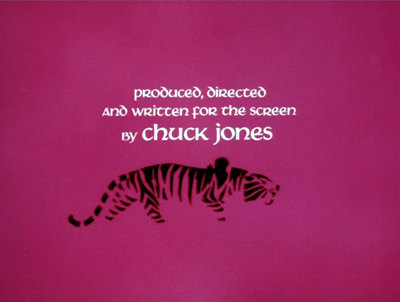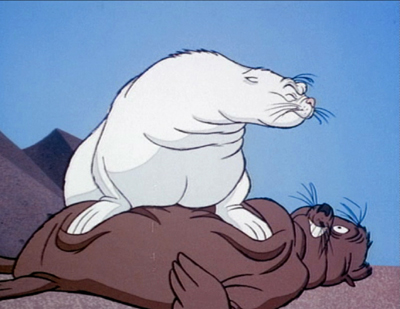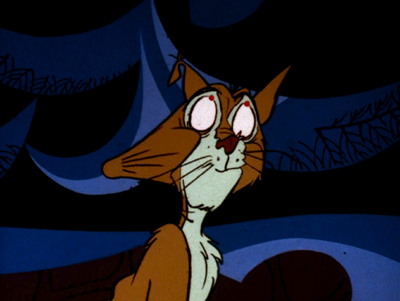
 BUY IT FROM AMAZON: CLICK HERE!
BUY IT FROM AMAZON: CLICK HERE!
STUDIO: Lionsgate
MSRP: $14.98
RATING: NR
RUNNING TIME: minutes
SPECIAL FEATURES:
- Heart and Soul: The Timeless Art of Chuck Jones
- Trailers
The Pitch
“Instead of selling three sets of Chuck Jones’ shorts, how about we fit them all onto one disc?”
The Humans
Mel Blanc, June Foray, Roddy McDowell, and Orson Welles.
The Nutshell
After parting ways with MGM in 1970, Chuck Jones started his own animation studio. This disc collects six of the TV specials he produced via this studio. In an age where films are envisioning as trilogies, either by the filmmakers or their devotees, let’s call these Jones’ “Kipling Trilogy” (Rikki-Tikki-Tavi, The White Seal, Mowgli’s Brothers) and his “Cricket Trilogy” (A Cricket in Times Square, A Very Merry Cricket, Yankee Doodle Cricket). Better yet, let’s not and never say we did.
The Lowdown
Getting the unpleasantness out of the way first, The White Seal is the weakest of the bunch. It’s the story of Kotick (or Kotex as I’ve taken to calling him) and his quest to find a safe haven for his flippered brethren. To find this haven, first he must find the ugly old sea cow. Since the sea cow is old, he obviously knows a place where humans won’t club the blubber out of the seals. Jones has been accused of being too cutesy, and The White Seal is pretty damning evidence. There isn’t a whole lot to the story, so we end up with a lot of filler. Baby Kotick playing with his mother takes up a few minutes of screen time. The same goes with Kotick swimming from one end of the world to the other and back again in his search for the sea cow. Things pick up towards the end. The safe haven is the crater of a volcano. The only way in is through an underwater tunnel. So the seals will be safe, and almost completely isolated from the rest of the ocean. Kotick’s plan hits a bump when the other seals end up not wanting to go. “What’s the life of a few?” they say. So Kotick and his father bully everybody into going. The isolationist bent and the “forcing you to do what’s good for you” are interesting ideas, but it’s too little too late.

Kotex likes to fuck victims of Joker venom. You got a problem with that?
Anyone familiar with Disney’s The Jungle Book should have an idea of what to expect from Mowgli’s Brothers, though Jones’ adaptation hews closer to the source material. Baby Mowgli wanders into the den of Father Wolf and Raksha. To protect Mowgli from Shere Khan, he is presented to the pack. In order to be accepted as a wolf cub, two must speak for Mowgli (which said using Kipling’s preferred pronunciation: mow rhymes with cow). Baloo the bear, a de facto member of the pack, speaks up and Bagheera the panther buys a vote with the carcass of a bull. Baloo and Bagheera take the man-cub under their paws and teach him the ways of the jungle. When Shere Khan makes his bid for revenge, Mowgli is ready for him. He drives Khan and his allies away with a burning branch. The story ends with Mowgli beginning the next phase in his adventure: returning to civilization. Roddy McDowell provides the narration. Since he’s technically reading the story (as the credits tell us), he provides the voices of all the male characters, which gives the proceedings a story time feeling. That and the (more) faithful adaptation is enough to make Mowgli’s Brothers worth a viewing. Plus Tabaqui the jackal bares more than a passing resemblance to a certain coyote.

"Wanna taste my honey?"
The Cricket specials are the collection’s biggest surprise. A Cricket in Times Square introduces us to the characters of Harry Cat, Tucker R. Mouse, and Chester Cricket. Chester lives in Connecticut and ends up following some liverwurst to New York City, via a picnic basket. Once in the city, he’s found by a boy whose family runs a failing newsstand in the Times Square-42nd Street subway station. Chester, with a little help from new friends Harry and Tucker, discovers that he is a musical prodigy. He uses his talent to bring success to the newsstand and a calm and tranquility that spread throughout the city. With his job complete, Chester goes back to Connecticut. A Very Merry Cricket is a direct sequel to Times Square. Without Chester’s influence the city is even more chaotic than before. Harry and Tucker set out for Connecticut to bring Chester, and some Christmas spirit, back to New York City. Yankee Doodle Cricket is a standalone special that tells the tale of how Harry, Chester, and Tucker’s ancestors played a role in the Revolutionary war.
Jones is a little more experimental in the Cricket specials than he is in the Kipling adaptations. As Chester plays at the end of Times Square, we get a montage of Jones’ artwork showing the denizens of New York listening to the music. Each drawing is as expressive as a photograph. We get a sense of who these people are just from seeing them for a few moments. The peace of this ending is directly contrasted by the beginning of A Very Merry Cricket. Another montage, whereas the earlier one was a calming journey, this one is a rapid assault that brings Van Gogh’s The Starry Night to mind. It’s rife with flashing neon colors, a spastic animatronic Santa, distorted reflections in ornaments, and a kid getting slapped. It’s scarier than anything in Rikki-Tikki-Tavi. Yankee Doodle Cricket is a pretty minor diversion. The nods to events and people of the Revolutionary war were enjoyable. I was rather taken by the fireflies that signal Paul Revere, John and Marsha. You might guess what their bit ended up being.

Oh, how Tom’s shadow longed for the return of George’s lower torso.
I loved the fuck out of Rikki-Tikki-Tavi when I was a kid. Later in life, I fucked the love out of Ricki Lake. It’s not something I’m proud of, but I don’t deny it. For those of you who had an unfulfilled childhood and never saw the glory that is Rikki-Tikki-Tavi, it’s the story of a mongoose. A flashflood deposits him at the Indian home of a British family. They take him in and in return he rids their garden of cobra couple Nag and Nagaina.
Unlike other childhood favorites (Bakshi’s Hobbit, raise your hand), Rikki stands the test of time. The key may lie in the pacing. There isn’t any time for things to slow down like in The White Seal. As soon as Rikki-Tikki gets acquainted with the house, he’s dealing with the cobras, and once he’s done with Nag, he’s got to deal with Nagaina threatening Teddy. Rikki’s also got a reputation as being too frightening for some kids, which is attributable to Jones’ direction. All the violence takes place off-screen. When Rikki-Tikki finishes Nag off, all we see is his back end, the whipping of Nag’s tail, and a shadow. The final confrontation between Nagaina and Rikki-Tikki happens in the cobra’s hole. Not only does it give our imaginations a chance to run wild, but it leaves us on the edge of our seats wondering if and when Rikki-Tikki’s going to reemerge. And when Orson Welles is narrating, there’s no way you aren’t going to be involved with what’s happening. Say what you will about the man, but he knew how to milk a story for all its worth.

"I’m Ed McMahon and this is Chestburster Bloopers!"
The Package
The picture quality is more than adequate. I’d say it’s on par with the Rocky & Bullwinkle season sets; not jaw-dropping, but satisfying. The featurette, Heart and Soul: The Timeless Art of Chuck Jones, is a 15-minute piece featuring June Foray, Jones’ widow Marian, and animator Eric Goldberg. They discuss Jones’ reasons for working on the specials, his working habits, and sing his praises. The best part is getting to see some of Jones’ sketches and storyboards. There are a few trailers, but the song on the Clifford trailer scared my testicles back into my abdomen, so I dared not venture further to see what other horrors awaited.